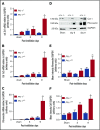Hematopoietic protease nexin-1 protects against lung injury by preventing thrombin signaling in mice
- PMID: 30254103
- PMCID: PMC6156894
- DOI: 10.1182/bloodadvances.2018018283
Hematopoietic protease nexin-1 protects against lung injury by preventing thrombin signaling in mice
Abstract
Coagulation and fibrinolytic system deregulation has been implicated in the development of idiopathic pulmonary fibrosis, a devastating form of interstitial lung disease. We used intratracheal instillation of bleomycin to induce pulmonary fibrosis in mice and analyzed the role of serine protease inhibitor E2 (serpinE2)/protease nexin-1 (PN-1), a tissue serpin that exhibits anticoagulant and antifibrinolytic properties. PN-1 deficiency was associated, after bleomycin challenge, with a significant increase in mortality, as well as a marked increase in active thrombin in bronchoalveolar lavage fluids, an overexpression of extracellular matrix proteins, and an accumulation of inflammatory cells in the lungs. Bone marrow transplantation experiments showed that protective PN-1 was derived from hematopoietic cell compartment. A pharmacological strategy using the direct thrombin inhibitor argatroban reversed the deleterious effects of PN-1 deficiency. Concomitant deficiency of the thrombin receptor protease-activated receptor 4 (PAR4) abolished the deleterious effects of PN-1 deficiency in hematopoietic cells. These data demonstrate that prevention of thrombin signaling by PN-1 constitutes an important endogenous mechanism of protection against lung fibrosis and associated mortality. Our findings suggest that appropriate doses of thrombin inhibitors or PAR4 antagonists may provide benefit against progressive lung fibrosis with evidence of deregulated thrombin activity.
© 2018 by The American Society of Hematology.
Conflict of interest statement
Conflict-of-interest disclosure: The authors declare no competing financial interests.
Figures








References
-
- Imokawa S, Sato A, Hayakawa H, Kotani M, Urano T, Takada A. Tissue factor expression and fibrin deposition in the lungs of patients with idiopathic pulmonary fibrosis and systemic sclerosis. Am J Respir Crit Care Med. 1997;156(2 Pt 1):631-636. - PubMed
-
- Kotani I, Sato A, Hayakawa H, Urano T, Takada Y, Takada A. Increased procoagulant and antifibrinolytic activities in the lungs with idiopathic pulmonary fibrosis. Thromb Res. 1995;77(6):493-504. - PubMed
Publication types
MeSH terms
Substances
LinkOut - more resources
Full Text Sources
Other Literature Sources
Molecular Biology Databases
Miscellaneous

